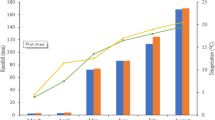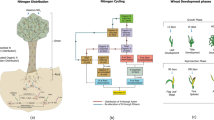Summary
The effects of concentration and source (NH4, NO3, and NO3 plus NH4) of added N on the rate of growth, final yield, and content and rate of intake of N, P, K, Ca, Mg and S by wheat seedlings were evaluated. Rate of growth in dilute liquid cultures differed among the N sources giving yields relative to those of the all-NO3 system of 92 per cent for the all-NH4 system, and of 154 per cent for the NO3 plus NH4 system. At low rates of NH4 intake in the all-NH4 systems growth rates were equal to or slightly better than those of plants supplied equivalent concentrations of NO3. Rates of NH4 intake exceeding 100 μmole g−1 h−1 resulted in reduced growth rates and incipient NH4 toxicity. Yields at 95 per cent of maximum resulted with steady-state N concentrations of 80 μM in all NO3 systems, 30 μM NH4 in all-NH4 systems, and in combined source systems when 200μM NO3 plus 30 μM NH4 were supplied. The rate of N intake and plant protein content, were maximal when both NO3 and NH4 were supplied. Increasing rates of NO3 intake were associated with increases in the rates of Ca, Mg, and K intake; but with increasing rates of NH4 absorption, intake of Ca and Mg decreased. The yield and growth rate enhancement observed from the addition of low concentrations of NH4 to cultures supplying adequate NO3 is suggested to result from the reduced energy requirement for utilization of NH4, as compared to NO3 in protein synthesis and from the increased photosynthetic capacity of the higher-protein NH4-fed plants. In the all-NH4 systems the maximum attainable growth rate was limited by NH4 toxicity; whereas in the all-NO3 systems the rate of NO3 reduction was limiting.
Similar content being viewed by others
References
Asher C. J. and Loneragan J. F., Response of plants to phosphate concentration in solution culture I. Growth and phosphorus content. Soil Sci.103, 225–232 (1967).
Barker A. V., Maynard D. N., and Lachman W. H., Induction of tomato stem and leaf lessions, and potassium deficiency by excessive ammonium nutrition. Soil Sci.103, 319–327 (1966).
Bennett A. C. and Adams F., Concentration of NH3 (aq) required for incipient NH3 toxicity to seedlings. Soil Sci. Soc. Am. Proc.34, 259–263 (1970).
Blair G. J., Miller M. H., and Mitchell W. A., Nitrate and ammonium as sources of nitrogen for corn and their influence on the intake of other ions. Agron. J.64, 530–532 (1970).
Borys M. W., Knaflewski M., and Wojciechowski J., Yield and mineral elements content of some tomato tissues as influenced by N-NO3:N-NH4 ratio and N level. Agrochimica14, 312–320 (1970).
Bremner, J. M., Total nitrogen.In C. A. Blacket al. (ed.) Methods of Soil Analysis. Agronomy9, 1149–1178 (1965).
Ferguson A. R. and Bollard E. G., Nitrogen metabolism ofSpirodela oligorrhiza I. Utilization of ammonium, nitrate, and nitrite. Planta88, 344–352 (1969).
Gamborg O. L., The effects of amino acids and ammonium on the growth of plant cells in suspension culture. Plant Physiol.45, 375–375 (1970).
Gamborg O. L. and Shyluk J. P., The culture of plant cells with ammonium salts as the sole nitrogen source. Plant Physiol.45, 598–600 (1970).
Gasser J. K. R., Nitrification inhibitors-their occurrence, production and effects of their use on crop yields and composition. Soils and Fertilizers33, 547–554 (1970).
Gerloff G. C., Comparative mineral nutrition of plants. Ann. Rev. Plant Physiol.14, 107–124 (1963).
Gibbs M. and Calo N., Factors affecting light induced fixation of carbon dioxide by isolated spinach chloroplasts. Plant Physiol.34, 318–323 (1959).
Goring C. A. I., Control of nitrification by 2-chloro-6- (trichloromethyl) pyridine, Soil Sci.93, 211–218 (1962).
Harada T., Takaki H., and Yamada Y., Effect of nitrogen sources on the chemical components in young plants. Soil Sci. Plant Nutr.14, 47–55 (1968).
Hewitt, E. J., Sand and water culture methods used in the study of plant nutrition. Commonwealth Agr. Bur. England Techn. Comm.22 (1966).
Johnson C. M. and Uhlrich A., Determination of nitrate in plant material. Anal. Chem.22, 1526–1529 (1950).
Jackson M. L., Soil Chemical Analysis. Prentice Hall Inc. Englewood Cliffs, New Jersey, p. 151 (1958).
Johnson C. M., Stout P. R., Broyer T. C., and Carlton A. B., Comparative chlorine requirements of different plant species. Plant and Soil8, 337–353 (1957).
Kirby E. A., Influence of ammonium and nitrate nutrition on the cation-anion balance and nitrogen and carbohydrate metabolism of white mustard plants grown in dilute nutrient solutions. Soil Sci.105, 133–141 (1968).
Maynard D. N. and Barker A. V., Studies on the tolerance of plants to ammonium nutrition. J. Amer. Soc. Hort. Sci.94, 235–239 (1969).
Minotti P. L., Williams D. C. and Jackson W. A., The influence of ammonium on nitrate reduction in wheat seedlings. Planta86, 267–271 (1966).
Naftel J. A., The absorption of ammonium and nitrate nitrogen by various plants at different stages of growth. J. Am. Soc. Agron.23, 142–158 (1931).
Pirschle K., Nitrate und Ammonsalze als Stickstoffquellen für höhere Pflanzen bei konstanter Wasserstoffionenkonzentration. Planta14, 583–676 (1931).
Reisenauer H. M., Mineral nutrients in soil solution.In Altman P. L. and Dittmer D. S. (eds.) Environmental Biology, Fed. Am. Soc. Exptl. Biol., Bethesda, Md. p. 507–508 (1966).
Reisenauer H. M., A technique for growing plants at controlled levels of all nutrients. Soil Sci.108, 350–353 (1969).
Shen T. C., The induction of nitrate reductase and the preferential assimilation of ammonium in germinating rice seedlings. Plant Physiol.44, 1650–1655 (1969).
Stahl A. L. and Shive J. W., Studies on nitrogen absorption from culture solutions I. Oats. Soil Sci.34, 375–399 (1933).
Syrett P. J., The assimilation of ammonia and nitrate by nitrogen-starved cells ofChlorella vulgaris: III. Differences of metabolism dependent on the nature of the nitrogen source. Physiol. Plantarum9, 28–37 (1956).
Thelin G. and Beaumont A. B., The effect of some forms of nitrogen on the growth and nitrogen content of wheat and rice plants. J. Am. Soc. Agron.26, 1012–1018 (1935).
Tromp J., Interactions in the absorption of ammonium, potassium, and sodium ions by wheat roots. Acta Bot. Neerl.11, 147–192 (1962).
Vines H. M. and Wedding R. T., Some effects of ammonia on plant metabolism and a possible mechanism for ammonia toxicity. Plant Physiol.35, 820–825 (1960).
Warren K. S., Ammonia toxicity and pH. Nature195, 47–49 (1962).
Williams R. F., The effects of phosphorus supply on the rates of intake of phosphorus and nitrogen and upon certain aspects of phosphorus metabolism in gramineous plants. Australian J. Sci. Research B1, 333–361 (1948).
Additional information
Contribution from the Department of Soils and Plant Nutrition, University of California, Davis, California 95616.
Rights and permissions
About this article
Cite this article
Cox, W.J., Reisenauer, H.M. Growth and ion uptake by wheat supplied nitrogen as nitrate, or ammonium, or both. Plant Soil 38, 363–380 (1973). https://doi.org/10.1007/BF00779019
Received:
Issue Date:
DOI: https://doi.org/10.1007/BF00779019




